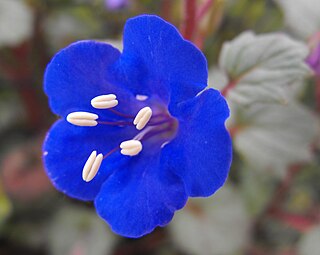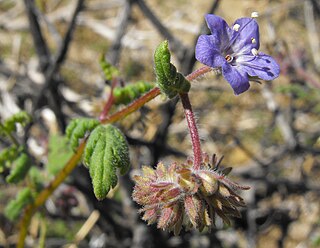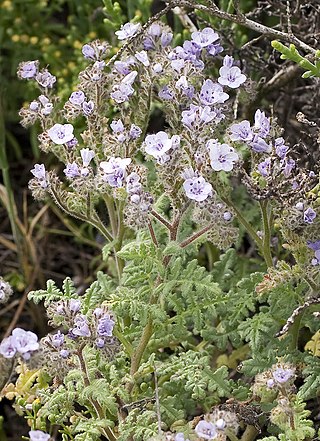
Phacelia fremontii is a flowering plant in the family Boraginaceae native to the southwestern United States. In California, its range includes the Mojave Desert, the San Joaquin Valley, the Coast Ranges, and the Sierra Nevada. It was named for John C. Frémont.

Phacelia minor, with the common names Whitlavia and wild Canterbury bells, is a species of phacelia. It is native to Southern California and Baja California, where it grows in the Colorado Desert and the coastal and inland mountains of the Transverse-Peninsular Ranges, often in chaparral and areas recently burned.

Phacelia campanularia is a species of flowering plant in the borage family, Boraginaceae, known by the common names desertbells, desert bluebells, California-bluebell, desert scorpionweed, and desert Canterbury bells. Its true native range is within the borders of California, in the Mojave and Sonoran Deserts, but it is commonly cultivated as an ornamental plant and it can be found growing elsewhere as an introduced species.

Festuca californica is a species of grass known by the common name California fescue.

Horkelia californica, known by the common name California horkelia, is a species of flowering plant in the rose family.
Phacelia adenophora is a species of phacelia known by the common name glandular yellow phacelia. It is native to the northwestern United States where it can be found in Oregon, northeastern California, and northwestern Nevada. It grows in mountain and plateau habitat. This is an annual herb producing decumbent, creeping, spreading, or upright branched stems up to 40 centimeters long. The leaves are oblong in shape and deeply lobed, measuring up to 3 centimeters long, and concentrated at the base. The inflorescence is a one-sided cyme of many bell-shaped flowers each under 1 cm long. The petals are fused at the base with five lobes. Unlike many phacelias, which bloom in shades of blue and purple, this species has yellow to golden flowers. It occasionally has purple edges on the corolla. It has five hairy stamens. The fruit is a fuzzy, oblong capsule a few millimeters in length containing up to 14 seeds.

Phacelia argentea is a rare species of phacelia known by the common names sand dune phacelia and silvery phacelia. It is native to the coastline of southwestern Oregon and far northwestern California, where it was counted at a total of 33 sites in 1995. It is the only phacelia species endemic to coastal sand dune habitat, an ecosystem which is altered and declining in the area.
Phacelia austromontana is a species of phacelia known by the common name Southern Sierra phacelia. It is native to the southwestern United States, where it can be found in the Transverse Ranges and Sierra Nevada of California east to Utah. It grows in open mountainous habitat.

Phacelia breweri is a species of phacelia known by the common name Brewer's phacelia.

Phacelia ciliata is a species of phacelia known by the common name Great Valley phacelia. It is native to California, where it can be found in many of the coastal mountain ranges, the Central Valley, and the Sierra Nevada foothills; its distribution extends into Baja California. It grows in grasslands and low mountain slopes.

Phacelia distans is a species of flowering plant in the borage family, Boraginaceae, known by the common names distant phacelia and distant scorpionweed. It is native to the southwestern United States and northwestern Mexico, where it grows in many types of habitat, including forest, woodland, chaparral, grassland, and meadows.

Phacelia divaricata is a species of phacelia known by the common name divaricate phacelia. It is endemic to California, where it grows in the coastal hills and mountain ranges around the San Francisco Bay Area and to the north. It grows in chaparral, woodland, grassland, and other local habitat.

Phacelia floribunda is a species of phacelia known by the common names many-flowered phacelia, southern island phacelia and San Clemente Island phacelia. It is known only from San Clemente Island, one of the Channel Islands of California, and Guadalupe Island off the coast of Baja California. It grows in coastal sage scrub habitat in the canyons of these two islands.

Phacelia grandiflora is a species of phacelia known by the common name largeflower phacelia. It is native to the coastal hills and southern Transverse Ranges of southern California and Baja California, where it grows in coastal sage scrub, chaparral, and other local habitat, including areas recently burned by wildfire.

Phacelia hydrophylloides is a species of phacelia known by the common name waterleaf phacelia. It is native to California, Oregon, and Nevada, where it can be found in the southern Cascade Range and the Sierra Nevada. It grows in mountain habitat such as meadows and forest.

Phacelia linearis, the linear-leaved phacelia or threadleaf phacelia, is a species of phacelia.

Phacelia parryi is a species of phacelia known by the common name Parry's phacelia.
Phacelia phacelioides, the Mt. Diablo phacelia, is a species of phacelia. It is endemic to California, where it is known from about 20 occurrences in the coastal mountain ranges of the inner San Francisco Bay Area, including Mount Diablo. It is a resident of chaparral and woodland habitat.

Phacelia stellaris is a rare species of flowering plant in the borage family, Boraginaceae, known by the common names star phacelia and Brand's phacelia.

Phacelia viscida is a species of phacelia known by the common names sticky phacelia and tacky phacelia.

















